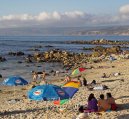Chile
Chile: Travel tips, articles, photos, gallery, cities database, population, pics, flags, statistics, free maps online
Back to Countries, Click to read the whole article: Chile
| Introduction - Chile: | | Location - Chile: | | People - Chile: | | Government - Chile: | | Economy - Chile: | Economy overview | Chile has a market-oriented economy characterized by a high level of foreign trade. During the early 1990s, Chiles reputation as a role model for economic reform was strengthened when the democratic government of Patricio AYLWIN - which took over from the military in 1990 - deepened the economic reform initiated by the military government. Growth in real GDP averaged 8% during 1991-97, but fell to half that level in 1998 because of tight monetary policies implemented to keep the current account deficit in check and because of lower export earnings - the latter a product of the global financial crisis. A severe drought exacerbated the recession in 1999, reducing crop yields and causing hydroelectric shortfalls and electricity rationing, and Chile experienced negative economic growth for the first time in more than 15 years. Despite the effects of the recession, Chile maintained its reputation for strong financial institutions and sound policy that have given it the strongest sovereign bond rating in South America. Between 2000 and 2006 growth ranged between 2%-6%. Throughout these years Chile maintained a low rate of inflation with GDP growth coming from high copper prices, solid export earnings (particularly forestry, fishing, and mining), and growing domestic consumption. Chile continues to attract foreign direct investment, but most foreign investment goes into gas, water, electricity and mining. Unemployment has exhibited a downward trend over the past year, dropping to 7.8% at the end of 2006. Chile deepened its longstanding commitment to trade liberalization with the signing of a free trade agreement with the US, which took effect on 1 January 2004. Chile signed or ratified a number of trade agreements in 2006, including with China and India. Chile claims to have more bilateral or regional trade agreements than any other country. It has 57 such agreements (not all of them full free trade agreements), including with the European Union, Mercosur, South Korea, and Mexico. | | Gdp purchasing power parity | $202.7 billion (2006 est.) | | Gdp official exchange rate | $111.8 billion (2006) | | Gdp real growth rate | 4.2% (2006 est.) | | Gdp per capita ppp | $12,700 (2006 est.) | | Gdp composition by sector | agriculture: 5.9%
industry: 49.3%
services: 44.7% (2006 est.) | | Labor force | 6.94 million (2006 est.) | | Labor force by occupation | agriculture: 13.6%
industry: 23.4%
services: 63% (2003) | | Unemployment rate | 7.8% (2006) | | Population below poverty line | 18.2% (2005) | | Household income or consumption by percentage share | lowest 10%: 1.2%
highest 10%: 47% (2000) | | Distribution of family income gini index | 53.8 (2003) | | Inflation rate consumer prices | 2.6% (2006) | | Investment gross fixed | 21% of GDP (2006 est.) | | Budget | revenues: $36.71 billion
expenditures: $26.68 billion; including capital expenditures of $3.33 billion (2006 est.) | | Public debt | 3.9% of GDP (2006 est.) | | Agriculture products | grapes, apples, pears, onions, wheat, corn, oats, peaches, garlic, asparagus, beans; beef, poultry, wool; fish; timber | | Industries | copper, other minerals, foodstuffs, fish processing, iron and steel, wood and wood products, transport equipment, cement, textiles | | Industrial production growth rate | 3.1% (2006) | | Electricity production | 47.6 billion kWh (2006) | | Electricity consumption | 48.52 billion kWh (2006) | | Electricity exports | 0 kWh (2004) | | Electricity imports | 1.744 billion kWh (2004) | | Oil production | 15,100 bbl/day (2006 est.) | | Oil consumption | 238,000 bbl/day (2006 est.) | | Oil exports | 31,510 bbl/day (2004) | | Oil imports | 222,900 bbl/day (2006 est.) | | Oil proved reserves | 150 million bbl (1 January 2006) | | Natural gas production | 1.09 billion cu m (2004 est.) | | Natural gas consumption | 8.29 billion cu m (2004 est.) | | Natural gas exports | 7.2 million cu m (2004 est.) | | Natural gas imports | 7.2 billion cu m (2004 est.) | | Natural gas proved reserves | 97.98 billion cu m (1 January 2005 est.) | | Current account balance | $5.063 billion (2006 est.) | | Exports | $58.21 billion f.o.b. (2006 est.) | | Exports commodities | copper, fruit, fish products, paper and pulp, chemicals, wine | | Exports partners | US 15.6%, Japan 10.5%, China 8.6%, Netherlands 6.7%, South Korea 5.9%, Italy 4.9%, Brazil 4.8%, France 4.2% (2006) | | Imports | $35.37 billion f.o.b. (2006 est.) | | Imports commodities | petroleum and petroleum products, chemicals, electrical and telecommunications equipment, industrial machinery, vehicles, natural gas | | Imports partners | US 15.6%, Argentina 12.6%, Brazil 11.8%, China 9.7% (2006) | | Reserves of foreign exchange and gold | $17.16 billion (November 2006 est.) | | Debt external | $47.6 billion (30 June 2006 est.) | | Economic aid recipient | $0 (2006) | | Currency code | Chilean peso (CLP) | | Exchange rates | Chilean pesos per US dollar - 530.29 (2006), 560.09 (2005), 609.37 (2004), 691.43 (2003), 688.94 (2002) | |
| Communications - Chile: | | Transportation - Chile: | | Military - Chile: |
This page was last updated on 16 September, 2007
Source: CIA >>> |




